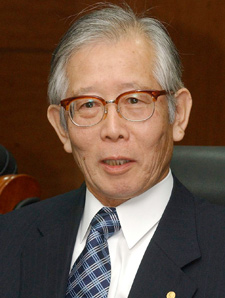1983 The Award of the Society of Polymer Science, Japan (FY 1982): Research on polyacetylene
2000 SPSJ Award for Outstanding Achievement in Polymer Science and Technology (FY 1982): Discovery and development of conductive polymer
2000 Nobel Prize in Chemistry: Discovery and development of conductive polymer
2000 Order of Culture and selected as Person of Cultural Merit
2001 Special Award of the Chemical Society of Japan
- Shirakawa Hideki; Ito Masahiko; Sato Moritoshi; Umezawa Yoshio; Miyazaki Shunichi. Measurement of intracellular IP3 during Ca2+ oscillations in mouse eggs with GFP-based FRET probe. Biochemical and biophysical research communications 2006;345(2):781-8.
- Kouchi Zen; Shikano Tomohide; Nakamura Yoshikazu; Shirakawa Hideki; Fukami Kiyoko; Miyazaki Shunichi. The role of EF-hand domains and C2 domain in regulation of enzymatic activity of phospholipase Czeta. The Journal of biological chemistry 2005;280(22):21015-21.
- Sone Yoshie; Ito Masahiko; Shirakawa Hideki; Shikano Tomohide; Takeuchi Hiroyuki; Kinoshita Katsuyuki; Miyazaki Shunichi. Nuclear translocation of phospholipase C-zeta, an egg-activating factor, during early embryonic development. Biochemical and biophysical research communications 2005;330(3):690-4.
- Asada Yasuki; Suzuki Shoichi; Yamada Masahiro; Sakurai Kumi; Susa Hiromi; Maeda Shigenobu; Ito Miyuki; Takeuchi Yoshihito; Shirakawa Hideki. [Effect of breast composition on patient exposure in mammography]. Nippon Hoshasen Gijutsu Gakkai zasshi 2004;60(12):1675-81.
- Yoda Ayako; Oda Shoji; Shikano Tomohide; Kouchi Zen; Awaji Takeo; Shirakawa Hideki; Kinoshita Katsuyuki; Miyazaki Shunichi. Ca2+ oscillation-inducing phospholipase C zeta expressed in mouse eggs is accumulated to the pronucleus during egg activation. Developmental biology 2004;268(2):245-57.
- Shirakawa Hideki; Miyazaki Shunichi. Blind spectral decomposition of single-cell fluorescence by parallel factor analysis. Biophysical journal 2004;86(3):1739-52.
- Shirakawa Hideki. [Fluorescence spectral component analysis by employing multivariate analysis and its application to experiments on cell physiology]. Nippon seirigaku zasshi. Journal of the Physiological Society of Japan 2004;66(12):381-90.
- Awaji T; Hirasawa A; Shirakawa H; Tsujimoto G; Miyazaki S. Novel green fluorescent protein-based ratiometric indicators for monitoring pH in defined intracellular microdomains. Biochemical and biophysical research communications 2001;289(2):457-62.
- Kanoh S; Kondo M; Tamaoki J; Shirakawa H; Aoshiba K; Miyazaki S; Kobayashi H; Nagata N; Nagai A. Effect of FK506 on ATP-induced intracellular calcium oscillations in cow tracheal epithelium. The American journal of physiology 1999;276(6 Pt 1):L891-9.
- Shirakawa H; Miyazaki S. Spatiotemporal characterization of intracellular Ca2+ rise during the acrosome reaction of mammalian spermatozoa induced by zona pellucida. Developmental biology 1999;208(1):70-8.
- Kondo M; Kanoh S; Tamaoki J; Shirakawa H; Miyazaki S; Nagai A. Erythromycin inhibits ATP-induced intracellular calcium responses in bovine tracheal epithelial cells. American journal of respiratory cell and molecular biology 1998;19(5):799-804.
- Nakano Y; Shirakawa H; Mitsuhashi N; Kuwabara Y; Miyazaki S. Spatiotemporal dynamics of intracellular calcium in the mouse egg injected with a spermatozoon. Molecular human reproduction 1997;3(12):1087-93.
- Shirakawa H; Miyazaki S. Spatiotemporal analysis of calcium dynamics in the nucleus of hamster oocytes. The Journal of physiology 1996;494 ( Pt 1)():29-40.
- Shiraishi K; Okada A; Shirakawa H; Nakanishi S; Mikoshiba K; Miyazaki S. Developmental changes in the distribution of the endoplasmic reticulum and inositol 1,4,5-trisphosphate receptors and the spatial pattern of Ca2+ release during maturation of hamster oocytes. Developmental biology 1995;170(2):594-606.
- Shirakawa H; Miyazaki S. Evidence for inositol tetrakisphosphate-activated Ca2+ influx pathway refilling inositol trisphosphate-sensitive Ca2+ stores in hamster eggs. Cell calcium 1995;17(1):1-13.
- Mohri H; Hamaguchi Y; Hamaguchi M S; Sano K; Shirakawa H; Nakada K; Miyazaki S. Sperm-egg fusion in the sea urchin is blocked in Mg(2+)-free seawater. Zygote (Cambridge, England) 1994;2(2):149-57.
- Miyazaki S; Shirakawa H; Nakada K; Honda Y. Essential role of the inositol 1,4,5-trisphosphate receptor/Ca2+ release channel in Ca2+ waves and Ca2+ oscillations at fertilization of mammalian eggs. Developmental biology 1993;158(1):62-78.
- Fujiwara T; Nakada K; Shirakawa H; Miyazaki S. Development of inositol trisphosphate-induced calcium release mechanism during maturation of hamster oocytes. Developmental biology 1993;156(1):69-79.
- Miyazaki S; Shirakawa H; Nakada K; Honda Y; Yuzaki M; Nakade S; Mikoshiba K. Antibody to the inositol trisphosphate receptor blocks thimerosal-enhanced Ca(2+)-induced Ca2+ release and Ca2+ oscillations in hamster eggs. FEBS letters 1992;309(2):180-4.
- Miyazaki S; Yuzaki M; Nakada K; Shirakawa H; Nakanishi S; Nakade S; Mikoshiba K. Block of Ca2+ wave and Ca2+ oscillation by antibody to the inositol 1,4,5-trisphosphate receptor in fertilized hamster eggs. Science (New York, N.Y.) 1992;257(5067):251-5.
�
�


